Wilmington and Western Railroad
The Wilmington and Western Railroad (reporting mark WWRC) is a freight and heritage railroad in northern Delaware, operating over a former Baltimore and Ohio Railroad (B&O) branch between Wilmington and Hockessin. The 10.2-mile (16.4 km) railroad operates both steam and diesel locomotives. It was added to the National Register of Historic Places as a national historic district in 1980.[1] Wilmington & Western serves one customer for revenue service, and interchanges with CSX Transportation at Landenberg Junction, Delaware
 | |
| Overview | |
|---|---|
| Headquarters | Marshallton, Delaware |
Wilmington and Western Railroad | |
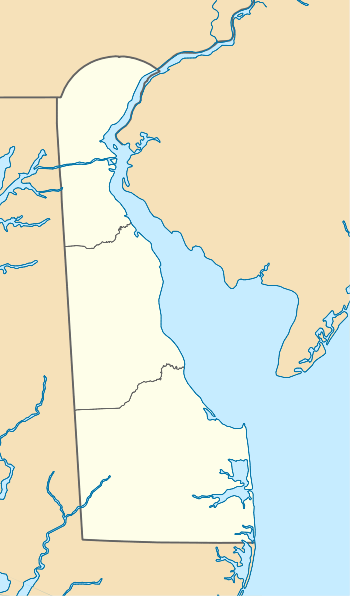  | |
| Location | 2201 Newport Gap Pike, Wilmington, Delaware |
| Coordinates | 39°44′17″N 75°37′58″W |
| Area | 73 acres (30 ha) |
| Built | 1867 |
| Architect | Wilmington & Western Railroad Co. |
| NRHP reference No. | 80000932[1] |
| Added to NRHP | September 8, 1980 |
| Reporting mark | WWRC |
| Locale | New Castle County, Delaware, USA |
| Dates of operation | 1872–1877, 1966–present |
| Technical | |
| Track gauge | 4 ft 8 1⁄2 in (1,435 mm) standard gauge |
| Other | |
| Website | wwrr.com |
Wilmington & Western's two General Motors Diesel-Electric SW1 locomotives are the oldest in routine scheduled service.
History
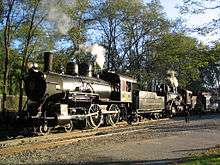
The Delaware and Chester County Railroad was incorporated in February 1867 to build from Wilmington in the direction of Parkesburg or Atglen, Pennsylvania,[2] and was renamed the Wilmington and Western Railroad in March 1869,[3] opening the line to Landenberg in 1872.[4] A foreclosure sale in April 1877 produced the Delaware Western Railroad, which was incorporated in June 1877 and merged into the Baltimore and Philadelphia Railroad, a B&O subsidiary, in February 1883.[3]
The B&O cut back the line to Southwood in the early 1940s and to Hockessin in the late 1950s. Historic Red Clay Valley, Inc. began operating steam tourist trains on weekends in 1966,[5] reusing the old W&W name, and in August 1982 the W&W bought the branch from the Chessie System for $25,000, which included Ex-B&O SW1 #8408 as a part of the purchase.[4][6] Under the Historic Red Clay Valley Inc. the operations are managed by a Board of Directors, paid staff and a large number of volunteers.[7]
In 1999, the rains of Hurricane Floyd caused considerable damage to the railroad. Two trestles were entirely destroyed by the flooding of Red Clay Creek, which also caused track washouts and damaged several other trestles. The two destroyed bridges were replaced by steel trestles, but the other timber trestles were simply repaired.
In 2003, Tropical Storm Henri struck the valley and produced an even more catastrophic flood. While the two steel bridges (and an iron trestle at Ashland) survived the flood, the remaining bridges were swept away or irreparably damaged. Despite the damage caused by these storms, the Wilmington and Western continued to operate on the remaining track, and replaced all of the destroyed bridges with steel trestles. The line officially reopened into Hockessin on June 30, 2007.
The railroad celebrated its 50th anniversary operating as a tourist railroad in 2016.[8]
Excursions
Several different excursions are offered by the Wilmington and Western Railroad, running through the Red Clay Creek valley. Trains operate out of the Greenbank station near the southern end of the railroad. The railroad offers two regular excursions which run on weekends during the operating season. The Hockessin Flyer runs round-trip from Greenbank to the northern end of the line in Hockessin for a 2.5-hour trip with a 30-minute layover in Hockessin. The Mt. Cuba Meteor runs round-trip from Greenbank to the Mount Cuba Picnic Grove for a 1.5-hour trip with a 30-minute layover for a picnic at the Mount Cuba Picnic Grove.
The Wilmington and Western Railroad also offers several special themed excursions. Some of the themed excursions include the Easter Bunny Express, the Fireworks Express on Independence Day, a dinner train called the Royal Blue Dinner Train, the Brews on Board train serving craft brews, the Civil War Skirmish Weekend, the Princess Express, the Superhero Express, the Autumn Leaf Special offering views of fall foliage, the Halloween Express, the Holiday Lights Express offering views of Christmas lights, and the Santa Claus Express around Christmas.[9] Groups may also charter a caboose, car, or entire train for an event.[10] A caboose attached to the end of a regularly scheduled train may be rented for birthday parties.[11]
Locomotives & rolling stock
Wilmington and Western Railroad | ||||||||||||||||||||||||||||||||||||||||||||||||||||||||||||||||||||||||||||||||||||||||||||||||||||||||||||||||||||||||||||||||||||||||||||||||||||||||||||||||||||||||||||||||||||||||||||||||||||||
|---|---|---|---|---|---|---|---|---|---|---|---|---|---|---|---|---|---|---|---|---|---|---|---|---|---|---|---|---|---|---|---|---|---|---|---|---|---|---|---|---|---|---|---|---|---|---|---|---|---|---|---|---|---|---|---|---|---|---|---|---|---|---|---|---|---|---|---|---|---|---|---|---|---|---|---|---|---|---|---|---|---|---|---|---|---|---|---|---|---|---|---|---|---|---|---|---|---|---|---|---|---|---|---|---|---|---|---|---|---|---|---|---|---|---|---|---|---|---|---|---|---|---|---|---|---|---|---|---|---|---|---|---|---|---|---|---|---|---|---|---|---|---|---|---|---|---|---|---|---|---|---|---|---|---|---|---|---|---|---|---|---|---|---|---|---|---|---|---|---|---|---|---|---|---|---|---|---|---|---|---|---|---|---|---|---|---|---|---|---|---|---|---|---|---|---|---|---|---|
| ||||||||||||||||||||||||||||||||||||||||||||||||||||||||||||||||||||||||||||||||||||||||||||||||||||||||||||||||||||||||||||||||||||||||||||||||||||||||||||||||||||||||||||||||||||||||||||||||||||||
Steam locomotives
- 4-4-0 American #98 was built by the American Locomotive Company of Schenectady, New York in January 1909 (construction #45921). The locomotive was built for the Mississippi Central Railroad of Hattiesburg, Mississippi. The engine ran for the Mississippi Central Railroad from 1909 to 1944, before it was sold to Paulsen Spence, the owner of the Louisiana Eastern Railroad. The engine was sold again to Thomas C. Marshall, in 1960, and was moved to the Strasburg Rail Road in 1961 for storage. The locomotive was moved to the Wilmington and Western in 1964 and would start operating on the Wilmington and Western in the fall of 1972. The Engine is currently one of two regularly operational American Type steam locomotives east of the Mississippi. The engine was taken out of service in 2017 for its Federally Mandated 1,472 Day Inspection.[12]
- 0-6-0 Switcher #58 was built by the Baldwin Locomotive Works of Philadelphia in October 1907 (construction #31899) for the Atlanta, Birmingham and Atlantic Railway, soon to become the Atlanta, Birmingham and Coast Railroad. The engine was numbered was originally numbered 58, but was renumbered to 27 before being pressed into service. The engine would find multiple owners over the years, including the United States Army, Virginia Blue Ridge Railway, and the Mead Company where it was renumbered 300. The engine was sold to Brian Woodcock in 1973, where he would renumber the engine back to 58 and store the engine at the Wilmington and Western Railroad until the mid-1980s, when it would be moved to Avondale, Pennsylvania. The engine was donated to the HRCV in 1997 by its owner with intentions for it to operate and would do so in the Late 1998. In November 2013, the engine was taken out of service due to a Federally Mandated 1,472 Day Rebuild. The engine was returned to operation in November 2017.[12]
- 2-6-0 Mogul #92 was built by the Canadian Locomotive Company of Kingston, Ontario in 1910 for the Grand Trunk Railroad (Soon to be owned by Canadian National Railway). The engine was classified as an E-8-a, but was reclassified as an E-12 and again to an E-10-a after being upgraded with Piston Valves and Superheating. The engine was renumbered to 919 in the 1920s and operated under that number until the mid 1950s when it and the rest of the E-10-a class were renumbered from 81-96, where it gained the number 92. 92 and most of the E-10-a class worked branch lines across the system. The engine was taken out of service in the late 1950s during the railroad's transition period to dieselization and was listed as surplus. In 1960 the locomotive was purchased by Thomas C. Marshall Jr. in 1960 for it to run on the Historic Red Clay Valley Inc.'s future railroad. It was moved down to Yorklyn, Delaware where it was rebuilt. It was the first steam locomotive to operate for the railroad when it became a tourist line. The engine operated from Spring of 1966 to Fall of 1972, when the engine was taken out of service due to mechanical issues. The engine is stored in Marshallton, awaiting restoration to operation.[12]
- 0-4-0F #1 was built for Delaware Power & Light by H.K. Porter in 1950. The Engine is a fireless locomotive, meaning it is a locomotive without a firebox. The locomotive was donated by Delmarva Power in 1981. The engine is currently stored in Marshallton. It will likely never operate at the W&W due to it being overall too small to operate their large trains.
- 0-6-0 Switcher #60 was built for the Pennsylvania Railroad in December 1913 classified as a B-6sa. The engine ran until the 1950s when it was taken out of service and purchased by the Cemline Corporation. The engine was purchased by a private owner was moved to Marshallton in the 1970s for storage. The engine was moved to Hockessin and has been sitting on one of the W&W's sidings. The locomotive was donated to HCRV in late 2019/early 2020, and now rests presumably in Marshallton Yard.
Diesel locomotives
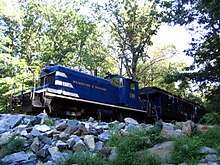
- SW-1 #114 was built in 1940 by the Electro-Motive Corporation (EMC) of General Motors for the Lehigh Valley Railroad. The engine operated for the Lehigh Valley Railroad for many years, eventually to be sold to the Maryland Port Authority as a switch engine in Pocomoke City, Maryland. In 1974, it was purchased for excursion service on the Ocean City Western Railroad in Ocean City, Maryland until that railroad shut down in the late 1970s, when the locomotive would go into storage in Snow Hill, Maryland. The engine would be purchased by the HRCV in 1992 in trade for ALCo S-2 #3. The engine has been in excursion and occasional freight service since 1993. This engine is currently stored serviceable.[13]
- SW-1 #8408 was built in 1940 by EMC of General Motors for the B&O and was originally numbered #208 before being renumbered to #8408 in February 1957. The locomotive served the B&O in freight service on the Landenberg Branch until 1982. It operated on the Tourist Line from 1982 until 2008, when it was taken out of service for a restoration of the locomotive. In 2011, it was shipped to McHugh Locomotive & Equipment in Fairless Hills, Pennsylvania for restoration. The Engine came back to the Wilmington and Western in February 2016, being officially pressed into service on May 28, 2016. The engine is now the main motive power on diesel-powered excursions.[13]
Self-propelled rail car
- Doodlebug #4662 (aka "The Paul Revere"); built by Pullman Standard for the Pennsylvania Railroad; in 1929. The engine ran for the Pennsylvania Railroad, mostly on Branchlines. The "Doodlebug" was retired in 1959, being sold to the National Capital Trolley Museum. The engine was purchased by the HRCV in 1967 and has operated since 1979. The engine is one of two Pennsylvania Railroad Doodlebugs still in existence. In early 2017, the "Doodlebug" was taken out of service to undergo a major rebuild of the front truck. The "Doodlebug" has returned to service and is operating on select Fridays during July and August 2018.[14]
Passenger cars
- Four DL&W Boonton passenger cars operate along the railroad. Combine #410, Coach #571, Coach #581, and Coach #603 were built in 1914-15 by the Pullman Company for the Delaware, Lackawanna & Western Railroad for commuter service as part of an order for 77 cars. The cars were in commuter service until the late 1950s, when newer passenger cars were pressed into service. The four Boonton passenger cars were purchased by HRCV in the early 1960s for passenger service. The passenger cars have been in service since May 1966.[15]
- Open-Air Coach #442 Kiamensi Springs was originally a locomotive-hauled PRR MP54 passenger car built by the Pennsylvania Railroad's Altoona Works in 1912. The car was converted to a MP54E6 EMU between 1950 and 1951 by adding electric traction motors. This coach car was used in commuter service for the Pennsylvania Railroad until being retired by 1978. Coach #442 arrived at the Wilmington and Western Railroad in 1988 and was converted into an open-air car in the late 1990s, entering service on May 23, 1999.[15]
- Parlor Car #6795 was built in 1930 by the Pullman Company for the Delaware, Lackawanna & Western Railroad as an EMU commuter coach numbered #2548. When the Delaware, Lackawannana & Western Railroad merged with the Erie Railroad to become the Erie Lackawanna Railway in 1960, #2548 was renumbered to #3548. The car was eventually purchased by Philadelphia radio personality Tom Moran, who placed it into storage in Woodstown, New Jersey. Moran painted the car into a Pennsylvania-Reading Seashore Lines scheme and renumbered it to #6795. The Wilmington and Western Railroad purchased #6795 on January 14, 1991 and kept the car in storage until early 2006, when it was restored and converted into a parlor car.[15]
Cabooses
- Caboose #C149 was built by the Erie Railroad at its Dunmore Shops in July 1941. The caboose saw service on the Erie Railroad and later the Erie Lackawanna Railway. In 1976, the Erie Lackawanna Railway became part of Conrail and #C149 was renumbered to #46195. The caboose eventually came to the Wilmington and Western Railroad as #C149 and was used on work trains. The caboose was refurbished in 2000 to be used for passengers and for birthday parties, entering revenue service on April 13, 2001. In 2016, the caboose was taken out of service for a major interior restoration.[16]
- Caboose #C2013 was built by the B&O at its Washington, Indiana shops in 1926 as a class I-5 caboose. It became a class I-5D when steel frame trucks were added. After coming to the Wilmington and Western Railroad, the caboose was restored to its original window placement and a back-up horn and lights were added. In summer 2005, the caboose had new roller-bearing trucks added and the wood siding replaced. In 2006, #C2013 underwent a restoration that reconstructed the interior and repainted the caboose into an authentic B&O scheme.[16]
- Caboose #C2042 was built by the B&O at its Washington, Indiana shops in August 1926 as a class I-5 caboose. It became a class I-5D when cast frame trucks were added. After coming to the Wilmington and Western Railroad, a back-up horn and lights were added. The caboose underwent an exterior restoration in 2013 that gave it a fresh coat of point, and underwent an interior restoration in 2016.[16]
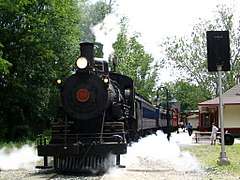 W&W #98
W&W #98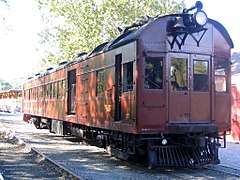 W&W #4662
W&W #4662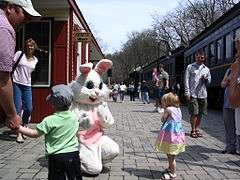
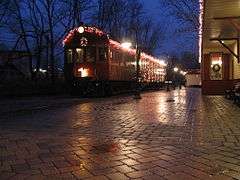 W&W #4662
W&W #4662
References
- "National Register Information System". National Register of Historic Places. National Park Service. July 9, 2010.
- An Act to incorporate the Delaware and Chester County Railroad Company, passed February 5, 1867
- Interstate Commerce Commission, 42 Val. Rep. 1 (1933): Valuation Docket No. 1068, The Baltimore and Ohio Rail Road Company and its Leased Lines
- Wilmington & Western Railroad: History, accessed February 2009
- Barry, Steve (2019-03-25). "A Visit to the Wilmington & Western Railroad". Railfan & Railroad Magazine. Retrieved 2019-05-16.
- John C. Rumm (1978). "National Register of Historic Places Inventory/Nomination: Wilmington and Western Railroad". National Park Service. and accompanying 11 photos
- Vazquez, Gisela (2008). The Wilmington and Western Railroad (Images of Rail: Delaware). USA: Arcadia Publishing. ISBN 978-0738553627.
- Ostroski, Drew (April 29, 2016). "Full Steam Ahead: Wilmington & Western Railroad Celebrates 50 Years". www.delawaretoday.com. Retrieved 2019-05-16.
- "Events & Fares". Wilmington and Western Railroad. Retrieved March 13, 2018.
- "Train Charters". Wilmington and Western Railroad. Retrieved March 14, 2018.
- "Birthday Caboose". Wilmington and Western Railroad. Retrieved March 14, 2018.
- "Steam Locomotives". Wilmington and Western Railroad. Retrieved March 14, 2018.
- "Diesel Locomotives". Wilmington and Western Railroad. Retrieved March 14, 2018.
- "Doodlebug". Wilmington and Western Railroad. Retrieved March 14, 2018.
- "Passenger Cars". Wilmington and Western Railroad. Retrieved March 14, 2018.
- "Cabooses". Wilmington and Western Railroad. Retrieved March 14, 2018.
External links
| Wikimedia Commons has media related to Wilmington and Western Railroad. |

